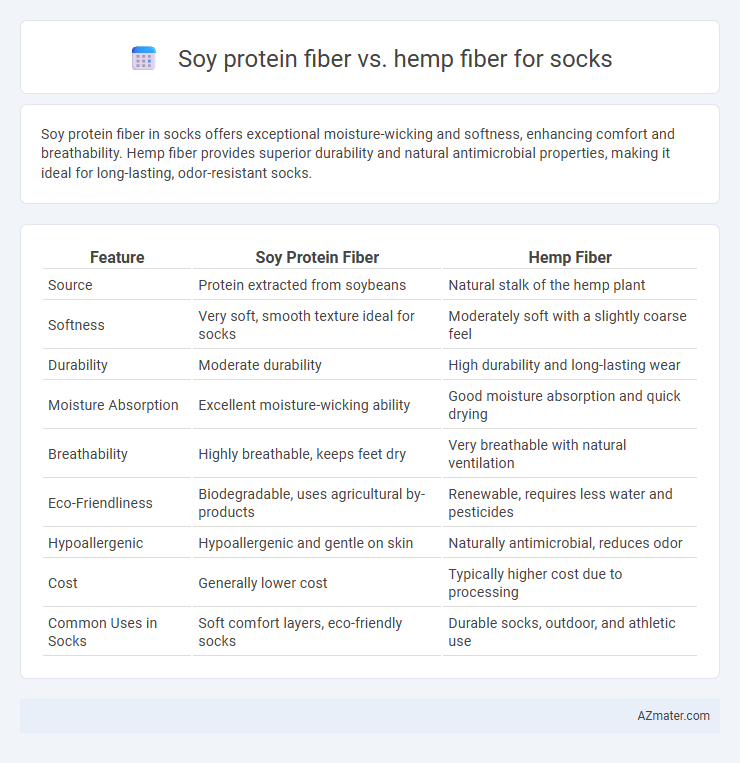Soy protein fiber in socks offers exceptional moisture-wicking and softness, enhancing comfort and breathability. Hemp fiber provides superior durability and natural antimicrobial properties, making it ideal for long-lasting, odor-resistant socks.
Table of Comparison
| Feature | Soy Protein Fiber | Hemp Fiber |
|---|---|---|
| Source | Protein extracted from soybeans | Natural stalk of the hemp plant |
| Softness | Very soft, smooth texture ideal for socks | Moderately soft with a slightly coarse feel |
| Durability | Moderate durability | High durability and long-lasting wear |
| Moisture Absorption | Excellent moisture-wicking ability | Good moisture absorption and quick drying |
| Breathability | Highly breathable, keeps feet dry | Very breathable with natural ventilation |
| Eco-Friendliness | Biodegradable, uses agricultural by-products | Renewable, requires less water and pesticides |
| Hypoallergenic | Hypoallergenic and gentle on skin | Naturally antimicrobial, reduces odor |
| Cost | Generally lower cost | Typically higher cost due to processing |
| Common Uses in Socks | Soft comfort layers, eco-friendly socks | Durable socks, outdoor, and athletic use |
Introduction to Soy Protein Fiber and Hemp Fiber
Soy protein fiber, derived from soybeans, is a sustainable and biodegradable material known for its softness, breathability, and moisture-wicking properties, making it ideal for sock manufacturing. Hemp fiber, obtained from the stalks of the hemp plant, offers exceptional durability, natural antibacterial qualities, and superior moisture absorption, which enhances sock longevity and comfort. Both fibers present eco-friendly alternatives with distinct benefits for socks, where soy protein fiber excels in softness and hemp fiber in strength and antimicrobial performance.
Understanding the Composition of Soy and Hemp Fibers
Soy protein fiber is derived from the proteins in soybeans, offering a soft, breathable texture with natural moisture-wicking properties ideal for socks. Hemp fiber, extracted from the stalks of the hemp plant, is highly durable, antimicrobial, and resistant to UV light, making it strong and long-lasting. The distinct molecular structures--soy protein's complex amino acid chains versus hemp's lignin and cellulose-rich composition--impact their performance, with soy providing softness and hemp ensuring toughness.
Environmental Impact: Soy vs. Hemp Fiber Production
Soy protein fiber production generates moderate water usage and greenhouse gas emissions due to intensive agricultural practices and processing methods, while hemp fiber cultivation requires significantly less water, fewer pesticides, and promotes soil health through crop rotation. Hemp's rapid growth and carbon sequestration abilities make its fiber an eco-friendlier option compared to soy protein fiber, which relies on genetically modified soybeans in some cases and chemical-intensive extraction processes. Consequently, hemp fiber socks offer a reduced environmental footprint with sustainable farming and biodegradability advantages over soy-based alternatives.
Comfort and Softness: Comparing Sock Feel
Soy protein fiber offers a remarkably soft and smooth texture, enhancing sock comfort by providing a gentle touch against the skin and excellent moisture absorption. Hemp fiber, while naturally breathable and durable, tends to be coarser but softens significantly with washing, offering a balance of comfort and longevity. Choosing between soy protein and hemp fibers for socks ultimately depends on prioritizing initial softness or long-term durability with improved comfort over time.
Moisture-Wicking and Breathability in Socks
Soy protein fiber offers excellent moisture-wicking properties due to its natural hydrophilic nature, effectively drawing sweat away from the skin to keep feet dry in socks. Hemp fiber is highly breathable, with an open structure that promotes air circulation and reduces heat buildup, making it ideal for preventing foot odor and maintaining comfort. Combining soy protein fiber's moisture management with hemp's superior breathability results in socks that excel in keeping feet dry and cool throughout the day.
Durability and Longevity of Soy and Hemp Socks
Hemp fiber exhibits superior durability and longevity compared to soy protein fiber, making hemp socks highly resistant to wear, tears, and repeated washing. Hemp fibers possess natural strength and antimicrobial properties, which extend the sock's life by preventing odor and degradation. While soy protein fiber offers softness and moisture absorption, it generally wears out faster under heavy use, resulting in shorter sock lifespan compared to hemp.
Allergenicity and Skin Sensitivity Considerations
Soy protein fiber is hypoallergenic and highly suitable for individuals with sensitive skin due to its smooth texture and moisture-wicking properties, reducing irritation in socks. Hemp fiber, although naturally antimicrobial and breathable, may cause mild irritation in people with extremely sensitive skin because of its coarser texture. Choosing soy protein fiber socks can minimize allergenicity risks and enhance comfort for users prone to skin sensitivity.
Sustainability and Biodegradability Factors
Soy protein fiber offers high biodegradability due to its plant-based origin and breaks down quickly in composting environments, reducing landfill waste. Hemp fiber is highly sustainable, requiring minimal water and pesticides to grow, and also biodegrades efficiently while providing durability and antimicrobial properties for socks. Both fibers present eco-friendly alternatives to synthetic materials, but hemp's robust environmental profile and biodegradability make it a superior choice for sustainable sock production.
Price Comparison: Soy Protein vs. Hemp Fiber Socks
Soy protein fiber socks typically cost less than hemp fiber socks due to lower raw material and processing expenses. Hemp fiber socks, known for their durability and antimicrobial properties, generally command a higher price point reflecting their premium quality. Consumers seeking affordable, eco-friendly socks often prefer soy protein fiber, whereas those prioritizing long-lasting wear may invest more in hemp fiber options.
Conclusion: Which Fiber is Better for Eco-Friendly Socks?
Hemp fiber outperforms soy protein fiber for eco-friendly socks due to its superior durability, moisture-wicking properties, and natural antimicrobial benefits, ensuring longer-lasting and more breathable socks. Hemp cultivation requires fewer pesticides and less water compared to soy, making it a more sustainable choice with a lower environmental impact. Therefore, hemp fiber is the preferred eco-friendly material for socks focused on sustainability and performance.

Infographic: Soy protein fiber vs Hemp fiber for Sock
 azmater.com
azmater.com